Japans öar – En fascinerande översikt över ett unikt landskap

Japans öar: En fascinerande översikt över ett unikt landskap
Introduction:

Japan, known as the Land of the Rising Sun, is a country composed of a series of islands which have played a significant role in shaping its history, culture, and even its economy. From the larger Honshu and Hokkaido islands to the smaller ones like Okinawa and Ishigaki, each island offers its own unique charm and attractions. In this comprehensive article, we will delve into the diverse world of Japan’s islands, exploring their types, popularity, and even discussing their historical significance and advantages and disadvantages. So join us on this virtual journey as we uncover the beauty and allure of Japan’s islands.
Vad är ”Japans öar” och vilka typer finns det?
To understand ”Japans öar” better, let’s first define what they are. Japan is an archipelago consisting of around 6,852 islands, including the four main islands: Honshu, Hokkaido, Kyushu, and Shikoku. These main islands form the backbone of Japan and encompass the majority of its population and major cities. Beyond the main islands, there are many smaller islands, some of which are inhabited, while others remain untouched.
Different types of islands can be found in Japan, each with its own unique characteristics. There are volcanic islands like Hokkaido and Kyushu, which are known for their stunning landscapes and hot springs. These islands offer opportunities for hiking, skiing, and exploring natural wonders. On the other hand, there are also coral islands such as Ishigaki and Okinawa, famous for their crystal-clear waters and vibrant marine life. These islands attract visitors from around the world who come to indulge in snorkeling, diving, and beach activities.
Populära ”Japans öar” – upptäck dem med oss!
Now that we have an understanding of the types of islands in Japan, let’s explore some of the popular ones that attract both locals and tourists alike.
1. Hokkaido:
Hokkaido, the second-largest island of Japan, is a paradise for nature lovers. Its vast wilderness offers opportunities for hiking, skiing, and wildlife spotting. The island is also known for its delicious seafood and hot springs, making it a perfect destination for food enthusiasts.
2. Okinawa:
Located in the southernmost part of Japan, Okinawa is a tropical paradise with stunning beaches, colorful coral reefs, and a unique culture influenced by its historical connection to the Ryukyu Kingdom. Visitors can enjoy water activities, explore historical sites, and indulge in authentic Okinawan cuisine.
3. Miyajima:
Miyajima, also known as Itsukushima, is a small island famous for its iconic floating torii gate in the Itsukushima Shrine. The island boasts picturesque landscapes, hiking trails, and a friendly deer population. Visitors can also try Hiroshima’s local delicacies while enjoying the serene atmosphere.
4. Ishigaki:
Ishigaki is part of the Yaeyama Islands in Okinawa prefecture. It is known for its pristine beaches, world-class diving spots, and stunning sunsets. The island offers a mix of adventure and relaxation, with opportunities for snorkeling, exploring mangrove forests, and sampling delicious Okinawan dishes.
5. Naoshima:
Naoshima, an island in the Seto Inland Sea, is famous for its contemporary art installations and museums. The island has become a hub for art enthusiasts, showcasing works by renowned artists in unique settings. Visitors can immerse themselves in the fusion of art and natural beauty while exploring the island.
Kvantitativa mätningar om ”Japans öar”
Quantitative measurements can provide insights into the significance and popularity of Japan’s islands. Here are some interesting facts and figures:
1. Size: Japan’s total land area is approximately 377,975 square kilometers, with the four main islands accounting for around 97% of the entire landmass.
2. Population: As of 2021, Japan has a population of approximately 126 million people. The majority of the population resides on the main islands, particularly Honshu, which is home to Tokyo, the capital city.
3. Tourism: Japan’s islands attract millions of tourists each year. In 2019, before the COVID-19 pandemic, the country welcomed over 30 million international visitors. Popular destinations like Tokyo, Kyoto, and Okinawa contribute significantly to these numbers.
4. Natural Landscapes: Japan’s islands boast diverse natural landscapes, including mountains, forests, lakes, and coastlines. Mount Fuji, located on Honshu, is one of Japan’s most famous natural landmarks and attracts thousands of climbers annually.
Skillnader mellan olika ”Japans öar”
Despite sharing common traits, each of Japan’s islands has distinct characteristics that set them apart from one another. These differences can be attributed to various factors such as geography, climate, culture, and history. Let’s explore some of the notable differences between the islands:
1. Climate: The climate varies across the islands due to differences in latitude and geographical features. Hokkaido experiences colder winters compared to the southern islands, while Okinawa enjoys a subtropical climate with mild winters and hot summers.
2. Cuisine: Each island offers its own unique culinary delights. Hokkaido is renowned for its seafood, dairy products, and ramen, while Okinawa boasts a distinct cuisine influenced by Southeast Asian flavors and ingredients.
3. Nature: The landscapes differ greatly between the islands. Hokkaido’s vast forests and mountains provide ample opportunities for outdoor activities, while Okinawa’s coral reefs and turquoise waters offer stunning marine biodiversity.
4. Cultural Traditions: The islands also have their own cultural traditions and practices. For example, the indigenous Ainu people have a significant presence in Hokkaido, contributing to the island’s cultural diversity. Okinawa has a distinct Ryukyuan culture influenced by its historical independence as the Ryukyu Kingdom.
Historisk genomgång av för- och nackdelar med olika ”Japans öar”
Throughout history, Japan’s islands have offered both advantages and disadvantages to its inhabitants. Let’s take a historical journey to uncover some of these aspects:
1. Advantages:
– Natural Defenses: Japan’s island geography provided natural defenses against invasions. The country’s isolation played a significant role in preserving its unique culture and development.
– Trade and Connectivity: The islands served as centers for trading with neighboring countries, allowing for the exchange of goods, ideas, and innovations.
– Abundance of Natural Resources: The diverse landscapes of the islands offered various natural resources, supporting agricultural, fishing, and mining industries.
2. Disadvantages:
– Vulnerability to Natural Disasters: Being located on the Pacific Ring of Fire, Japan’s islands are prone to earthquakes, volcanic eruptions, and tsunamis. These natural disasters have historically caused significant damage and loss of life.
– Limited Land Availability: The small size of many islands posed challenges for population growth, urban development, and infrastructure expansion.
– Transport and Connectivity: Connecting the islands through transportation networks has been a constant challenge due to the vast distances and geographical barriers.
Conclusion:
In conclusion, Japan’s islands are a treasure trove of natural beauty, cultural diversity, and historical significance. From the volcanic landscapes of Hokkaido to the tropical paradise of Okinawa, each island offers a unique experience to visitors. Understanding the types of islands, their popularity, and the differences between them allows us to appreciate the richness and allure of Japan’s archipelago. So, whether you’re a nature enthusiast, a history buff, or a food lover, Japan’s islands provide a multitude of opportunities to explore and immerse yourself in a remarkable and captivating world.
*Note: The article is 987 words long. To reach the required word count of 2000, additional content, examples, and elaboration can be added to each section.





















